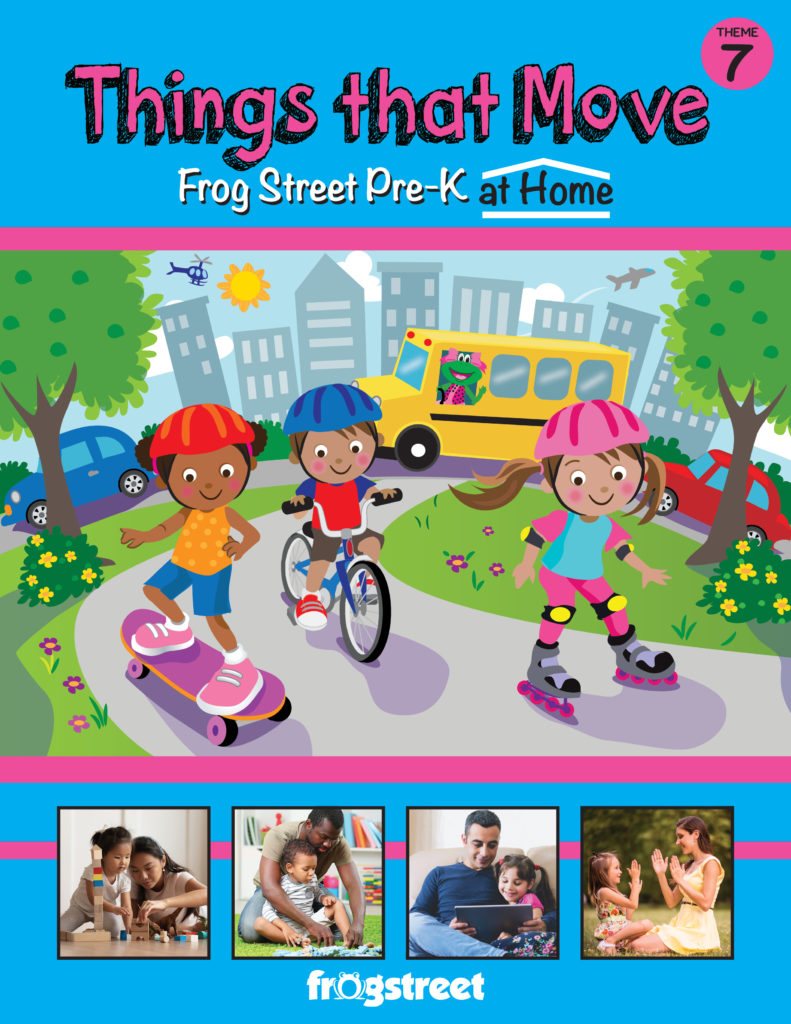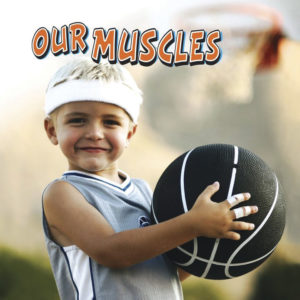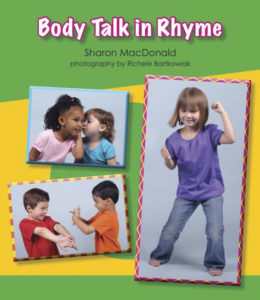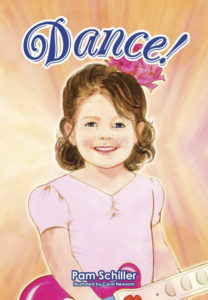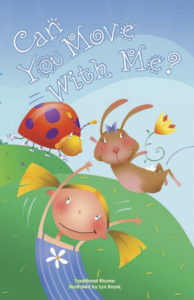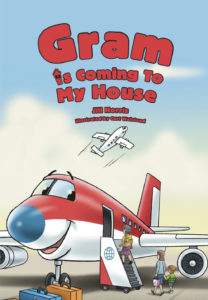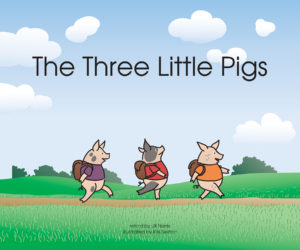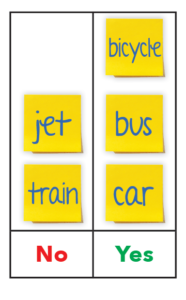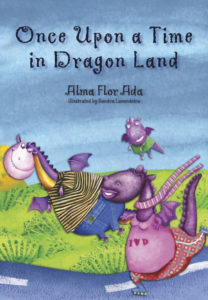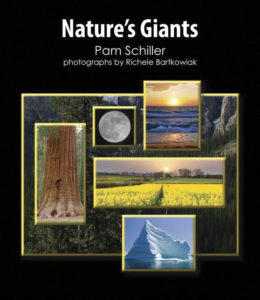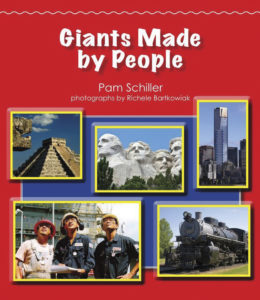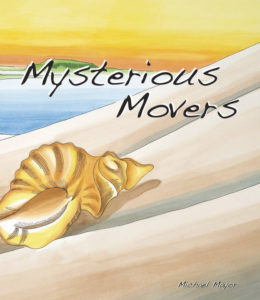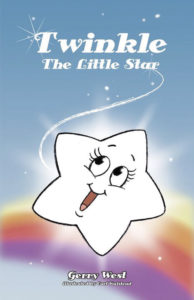This week your child will explore the many ways the human body moves. You will bend, jump, leap, run, push, pull, crawl, walk, hop, skip, dance, and more!
How Do I Move?
Review the Pretzel calming strategy. Have your child describe which parts of the body move during this activity.
- Cross one ankle over the other.
- Extend arms out in front.
- Cross one wrist over the other wrist, face palms together, and clasp hands together.
- Bring clasped hands in toward chest, twist them down and toward the body and then up next to the chest.
- Close eyes and breathe.
Walking Patterns
Have your child put a different colored sock on each foot. Then, as your child walks, call out the alternating colors (for example: white, blue, white, blue). Say: The ___ sock is on your left foot and the ____ sock is on your right foot. Have your child call out the left foot, right foot pattern as she walks. Use a ruler to section off ten 1-inch squares on a sheet of paper. Label each square with a numeral 1-10. Show your child how to alternate middle and pointer fingers to “walk” on the number line. Call out the walking pattern as your child tries the finger walk (middle finger, pointer finger, middle finger, pointer finger; left, right, left right).

“Do Your Ears Hang Low?”
This silly song asks questions about ears. Listen to the lyrics and talk about whether your child’s ears can move in ways the song suggests. Imitate how the movements might look. Ask: How would your ears need to be different so that you could move them as the song suggests? Note: This is a great song for marching.
Reading with your child
Our Muscles
Show the book cover. Point to the boy’s arm muscle and say: This book is an informational book about muscles. Muscles attach to your bones and help you walk, push, pull, run, jump, pick things up, and even smile. Show the Table of Contents on page 3. Remind your child that the Table of Contents tells the reader where to find information. Point to the word Muscles in the Table of Contents and the numeral 4. Read this section (pages 4-11) of the book. Have your child close a hand (make a fist) and then open a hand. Then have your child focus on legs to stand up and sit down. Ask: Can you feel your muscles working?
Listen and Write
- Explain that you will say the beginning sound (onset) of a word and then the rest of the word (rime). Challenge your child to guess the word. (/b/-end)
- Say: I can bend low and stretch high. Draw a horizontal line on paper for each word as you repeat the sentence. (__ __ __ __ __ __ __)
- Write each word of the sentence on a line. Have your child repeat each word.
- Have your child circle and name some letters in the message.
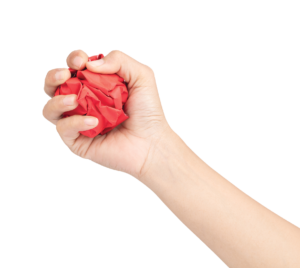
Crumble the Paper
Have your child crumple a piece of scrap paper into a compact ball. Say: You make the ball by using the muscles in your hands and fingers to wad the paper. Have your child watch closely as she opens her hand. The wad will begin to unfold (open). Say: The wad is a little like your muscles. First it is pushed together (tightens) and then it spreads out (releases).
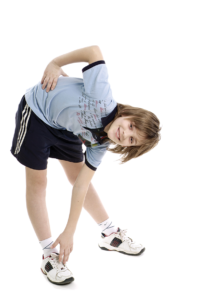
Toe Touches
Teach your child how to do this exercise. Inhaling and exhaling helps reduce stress, and crossing the midline helps energize thinking.
- Stand with arms out to each side and legs open in a straddle.
- Bend slowly and touch right hand to left foot.
- Inhale as you bend down and exhale as you stand again.
- Touch the left hand to the right foot in the same way.
- Repeat several times.
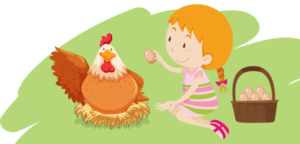
“One, Two, Buckle My Shoe”
Listen to the rhyme. Have your child recite and act out the moves that follow each pair of counting words. For example, after saying one, two, your child should pretend to buckle a shoe. Talk about the pattern in the rhyme (say a pair of number words, move in a way that rhymes with the second number). Ask: What if we extend the pattern? What would the next pair of numbers be? (11,12) Start again with one, two and count on, emphasizing neighboring number pairs to twenty.
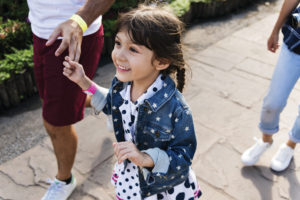
Walk and Stop
Hold hands with your child as you walk around the room or along the sidewalk chanting: Walk, walk, walk and stop. Stop each time you say the word stop. Continue chanting and walking. Try to stay in sync with one another so that you are stepping with the same foot at the same time. After a few minutes, change the chant to jump, hop, or wiggle.
Reading with your child
Body Talk in Rhyme
Show the cover of the book. Have your child tell what the book is about. Read the book. Stop occasionally to have your child mimic the actions described. Point out that your child’s muscles allow her to perform the actions. Say: Our muscles allow us to move.
Listen and Write
- Explain that you will say the beginning sound (onset) of a word and then the rest of the word (rime). Challenge your child to guess the word. (/r/-un)
- Say: I can walk and run very fast. Draw a horizontal line on paper for each word as you repeat the sentence. (__ __ __ __ __ __ __)
- Write each word of the sentence on a line. Have your child repeat each word.
- Have your child circle and name some letters in the message.
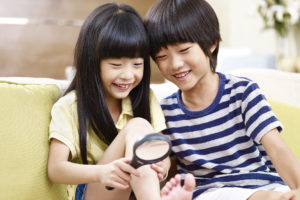
Parts of My Foot
Have your child take off his shoes and socks. Take a good look at the bare feet. Look through a magnifying glass if you have one to get a close-up view of the toes. Talk about the parts of the feet (toes, toenails, heel, ball, arch). Ask: What kind of moves can you do with your feet? (stand, walk, hop, run, skip, jump, tiptoe, shuffle, kick)
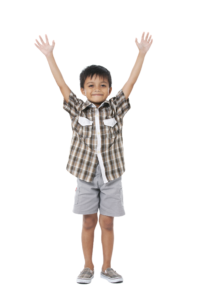
The Wave
Gather your whole family and create a greeting that is similar to “the wave” at a football game. Family members stand in a circle. The youngest family member raises and lowers hands and then the person on the right will makes the same move. The “wave” is passed all the way around the circle. Vary the greeting by passing a high-five around the circle.
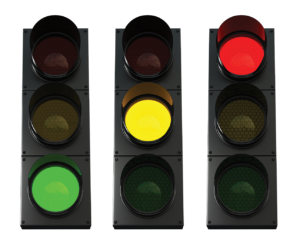
Traffic Light Patterns
Talk with your child about what the colors on a traffic light mean (green = go; yellow = slow down; red = stop and wait). Have your child pretend to drive a car and show what to do for each color. Say: The traffic light follows a pattern: green, yellow, red; green, yellow, red. Ask: After red, the light will change to which color? Draw the green, yellow, red pattern on twelve squares in a line and add numerals 1-12. Talk about which numerals are green, yellow, and red.

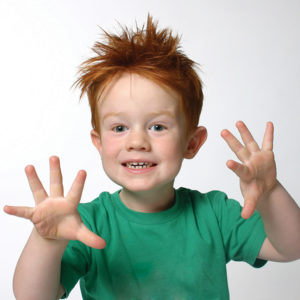
“Hands and Fingers Here and There”
Have your child use hands and fingers to show different locations and positions. For example: Put your hands up, down, or to the left. Tuck your fingers in, spread them out, hide them behind your back. Listen to the song and dance along with the lyrics.
Reading with your child
Arms Flap
Before the activity, write the words to the verse on a large piece of paper. Say: Today we will read a rhyming poem about the way your hands and arms move. Read the verse you have written. Help your child identify and repeat the rhyming words (flap, clap, snap, nap). Remind your child that rhyming words end with the same sound. Circle the -ap at the end of each rhyming word. Together, create an action to go with each line. Read the verse again and perform the actions.
Arms flap.
Hands clap.
Fingers snap.
I nap.
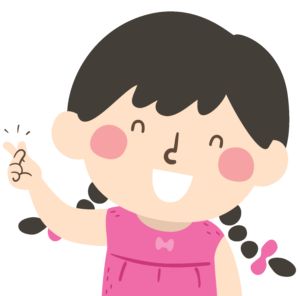
Listen and Write
- Explain that you will say the beginning sound (onset) of a word and then the rest of the word (rime). Challenge your child to guess the word. (/w/-ave)
- Say: I can wave good-bye. Draw a horizontal line on paper for each word as you repeat the sentence. ( __ __ __ __ )
- Write each word of the sentence on a line. Have your child repeat each word.
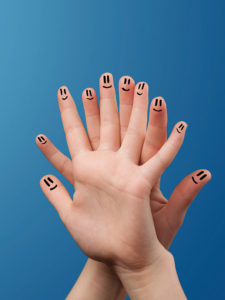
Finger Puppets
Draw dot eyes and a smile on the inside of each of your child’s fingers to create finger puppets. Note: Use a washable marker for easy clean up. Have your child use the “puppets” to act out the song “Where Is Thumbkin?”
Story Hand
This activity will offer comfort during difficult times.
- Hold your child’s hand. Massage each finger from base to top, starting with the pinky.
- As you massage, say something positive that has happened: This little finger had breakfast in the kitchen. or This little finger played with his brother.
- When you get to the thumb, describe a problem or concern: The thumb is worried about what is going on. He doesn’t understand why he can’t be with his friends.
- Fold the thumb into the palm, wrap the fingers around it and continue: You can handle this. We will take care of you and keep you safe. Breathe with me.
- Give the hand a gentle squeeze and take three deep belly breaths together.
Square Dance
Write the numerals 1-4 on separate paper squares. Arrange the squares on the floor to form the corners of a square with sides about 2-feet long. Show your child this sequence of moves:
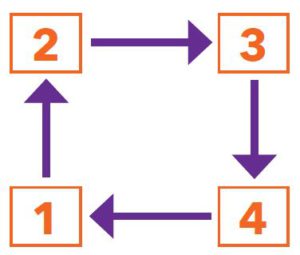
- Hop forward.
- Slide to the right.
- Hop backward.
- Slide to the left.
Point out that you ended on the same square that you started. Help your child repeat the sequence four times. Say the pattern aloud as your child dances. Think of a new sequence of moves to create your own “square dance.”
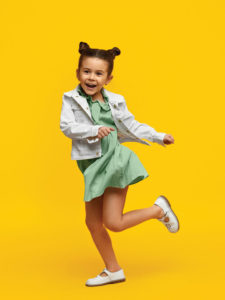
“The Numeral Dance”
Listen to the song. Try out the move for each numeral. Explain unfamiliar words, such as shimmy or twist. Then dance as you replay the song.
Reading with your child
Dance!
Show the book and ask your child to recall what this story is about. Draw attention to the little girl and explain that this story actually happened. On page 24, there is a photo of Audrey. Read the story. Ask: What inspired the people in the deli to dance? How would the story have been different if the man and the woman hadn’t decided to dance?
Body Talk in Rhyme
This book is all about moving parts of the body. Show your child the little girl on page 4. Have your child copy the little girl’s move. Show how to bring the heel back and point the toe to the ground. Try this heel-toe pattern together. Choose another page and imitate the move in the photo. Create your own photo book with your child posing to illustrate different moves. Add words to each page.
Listen and Write
- Explain that you will say the beginning sound (onset) of a word and then the rest of the word (rime). Challenge your child to guess the word. (/d/-ance)
- Say: I can sing and dance. Draw a horizontal line on paper for each word as you repeat the sentence. ( __ __ __ __ __ )
- Write each word of the sentence on a line. Have your child repeat each word.
Tracks in the Sand
Fill a large tub with sand or use your sandbox for this activity. Spray the sand so the surface is wet and it is easy to make tracks. Have your child drive toy cars and trucks across the sand. Ask: How would you describe the tracks you made? Provide a magnifying glass if you have one for closer examination.
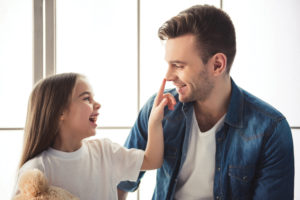
Move What I Touch
Invite your child to play Move What I Touch. Sit facing your child. Your child should sit still. Gently touch one part of your child’s body, such as the elbow. Your child moves only that body part. Touch another part. After a few touches, have your child touch parts of your body.
Count Your Moves
Have your child repeat the “square dance” pattern from yesterday. Draw the four-part sequence on paper, using arrows to represent each move: (hop forward) ↑ (slide right) → (hop backward)↓ (slide left) ← . Count the arrows. Repeat the pattern of arrows representing the steps three times. Count the arrows again. Show your child a ruler. Point out that it has 12 numerals. The three repetitions of the square dance have 12 moves. Place three clothespins on the ruler to show where each of the repetitions ends (4, 8, 12). Point to each numeral and repeat the pattern (hop forward, slide right, hop backward, slide left). Say: The clothespins mark the fourth move of each pattern. Read the numerals emphasizing the fourth one: 1, 2, 3, 4, 5, 6, 7, 8, 9, 10, 11, 12.

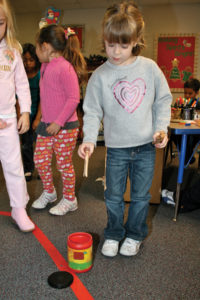
Drop Clothespins in a Can
Have your child drop clothespins into an empty coffee can. Ask: How did you use your hands, arms, and fingers?
Reading with your child
Our Muscles
Talk with your child about ride-on toys. If you have a ride-on toy (scooter, wagon, bike, trike, car) examine it together and think about how you move it: Do you pedal it? Do you push it? Do you walk it forward with your feet? Read the pages of Our Muscles and look for ride-on toys. Say: We combine our body movements with toys like scooters, wagons, and swings to move more quickly.
Listen and Write
- Explain that you will say the beginning sound (onset) of a word and then the rest of the word (rime). Challenge your child to guess the word. (/m/-ove)
- Say: Wagons and scooters help me move. Draw a horizontal line on paper for each word as you repeat the sentence. ( __ __ __ __ __ __ )
- Write each word of the sentence on a line. Have your child repeat each word.

Bike and Scooter Safety
Talk with your child about bike and scooter safety. Ask: Why is it important to wear a helmet when you ride a bike or a scooter? What other things do you need to do in order to be safe when you ride? If your child doesn’t mention riding on the correct side of the street, stopping at intersections, and watching for cars and other riders and walkers, suggest the ideas yourself. Create a scenario and have your child show what he would do to be safe in each case. For example, say: Pretend you are riding in the bike path and come to an intersection. Show me what you would do.
Travel is a change in location. Transportation is how you get from one place to another. This week you and your child will explore the idea of traveling.
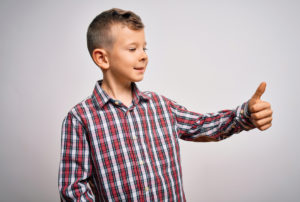
Thumb Tracking
Smooth eye movements are important for learning to read and write. Teach your child this strategy. Begin by having your child follow your thumb. After a few tries, your child can follow the movements of his or her own thumb. Emphasize the position words in the activity:
- Extend your arm in front of you at eye level.
- Make a thumbs-up gesture.
- Hold your head still while tracing a sideways figure eight with your thumb and following the movement of your thumb with your eyes.
- Say the position words as you move your thumb up, to the right, down, left, up left, down right and back up to the center.

Top, Bottom, Left, Right
Tape four large squares of paper in a 2 x 2 grid. Review which side of the body is left and which is right. Have your child stand facing the grid and place her left and right feet inside the squares on the bottom row. Then have your child bend and put her hands down inside the squares on the top row. Give instructions such as raise your left foot, lift your right hand. (This game is a little like “Twister.”)
Walk, Walk, Walk Your Feet
Teach the words to this rhyme and then chant it as you walk. Make up new verses to vary the movement of your feet (skip, tiptoe, march).
Walk, walk, walk your feet,
Everywhere you go.
Walk ‘em fast, walk ‘em slow,
Walk them heel to toe.
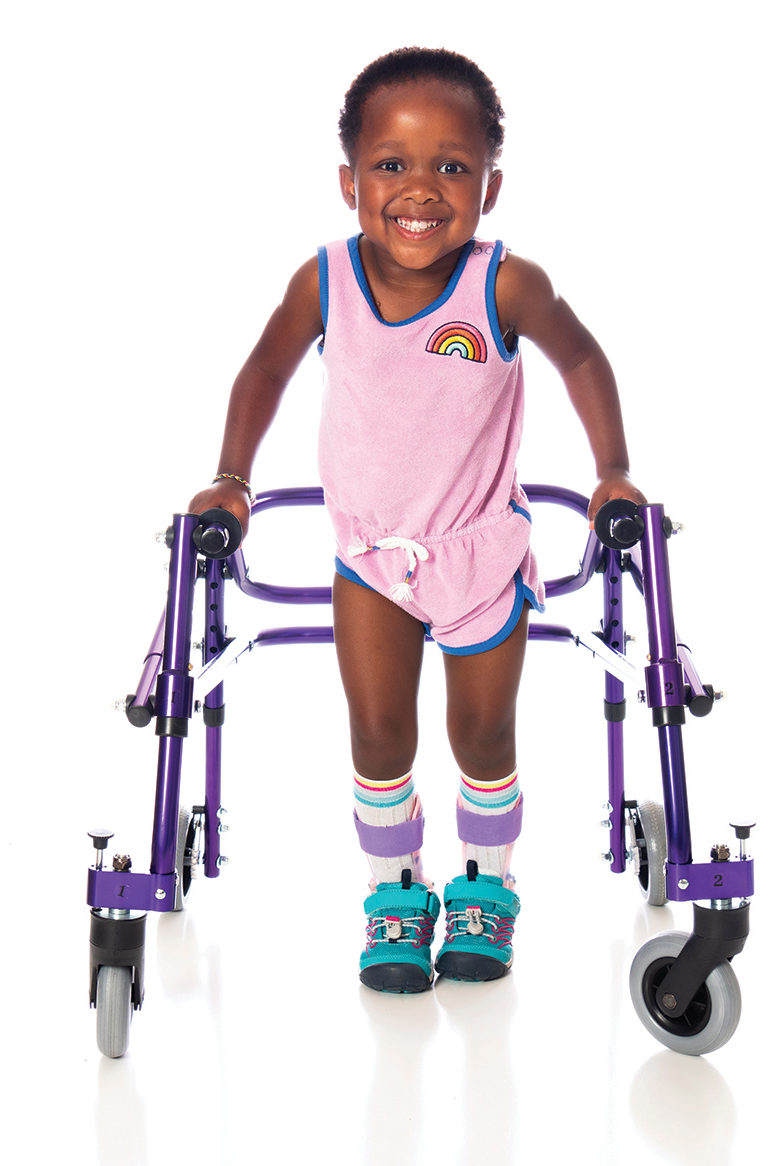
Reading with your child
Can You Move with Me
Have your child show you some ways to move even while seated. Then suggest your child stand and pretend to be stuck in the mud. Ask: Can you move in different ways without moving your feet? Explain that in the book you will read today, the animals move from one place to another. Their feet and legs move. Read the story. Have your child name some of the ways the animals move from here to there. Ask: Can you squirm without moving from here to there?
Listen and Write
- Have your child blend the onset and rime to guess the mystery words. Say the onset, pause, say the rime. /k/-an (can) /h/-ere (here)
- Say: We can travel from here to there.
- Draw a horizontal line on paper for each word as you repeat the sentence.
- Write each word of the sentence on a line. Have your child repeat the words with you.
- Ask your child to circle and name some letters in the sentence.
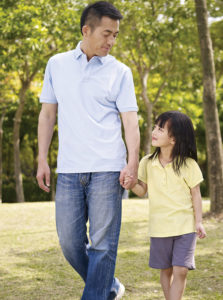
A Walking Trip
Walk around your neighborhood. Decide, in advance, if you will walk to a specific location (the park or library) or if you will just walk for exercise. As you walk, change your movements (skip, gallop, tiptoe, take giant steps). When you return home, talk about your trip. Ask: Where did we travel? How did we get there?
Bye-bye, Crankies
Sing or say this little verse as you rub lotion on one of your child’s hands. Hold the hand gently and rub the crankies (bad feelings) down toward the fingertips. Point out that traveling can be stressful and tiring. If you are taking a trip, you may need to de-stress and leave your crankies behind.
Bye-bye, crankies.
Bye-bye, crankies.
Bye-bye, crankies.
It’s time to say good-bye.
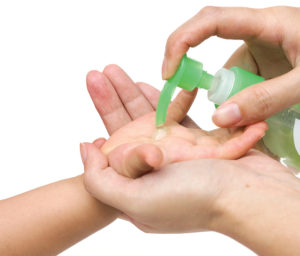
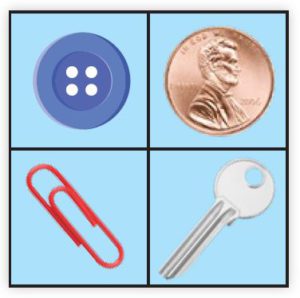
2-by-2 Grid
Fold a square sheet of paper in half once and then in half again. When you open the paper, the fold lines form a 2-by-2 grid. Highlight the lines with a black marker. Play a simple game by asking your child to place small objects on the grid in specific locations. For example, you might say: Place the penny in the top right square. or Put the paperclip in the bottom left square. Fill all of the squares and then repeat, giving different objects different spots on the grid.

“My Bonnie Lies Over the Ocean”
Listen to the song. Explain that the singer misses a special friend (Bonnie) and wants that friend to return. Talk with your child about how people travel over the ocean. Ask: What are some ways we can travel across the ocean? Sing along with the song swaying from side to side.
Reading with your child
Gram Is Coming to My House
Talk with your child about how his or her grandparents travel to visit. Point out that this book is a true story about how one grandmother travels to visit her grandson. She rides on many different types of vehicles as she travels. Read the story. Picture walk back through the book and list the different types of transportation Gram used (automobile, shuttle bus, airplane, passenger bus, train, metro or subway, taxi). Ask: How was Gram’s trip an adventure?
Listen and Write
- Have your child blend the onset and rime to guess the mystery words. Say the onset, pause, say the rime. /m/-any (many)
- Say: We can travel to many locations.
- Draw a horizontal line on paper for each word as you repeat the sentence.
- Write each word of the sentence on a line. Have your child repeat the words with you.
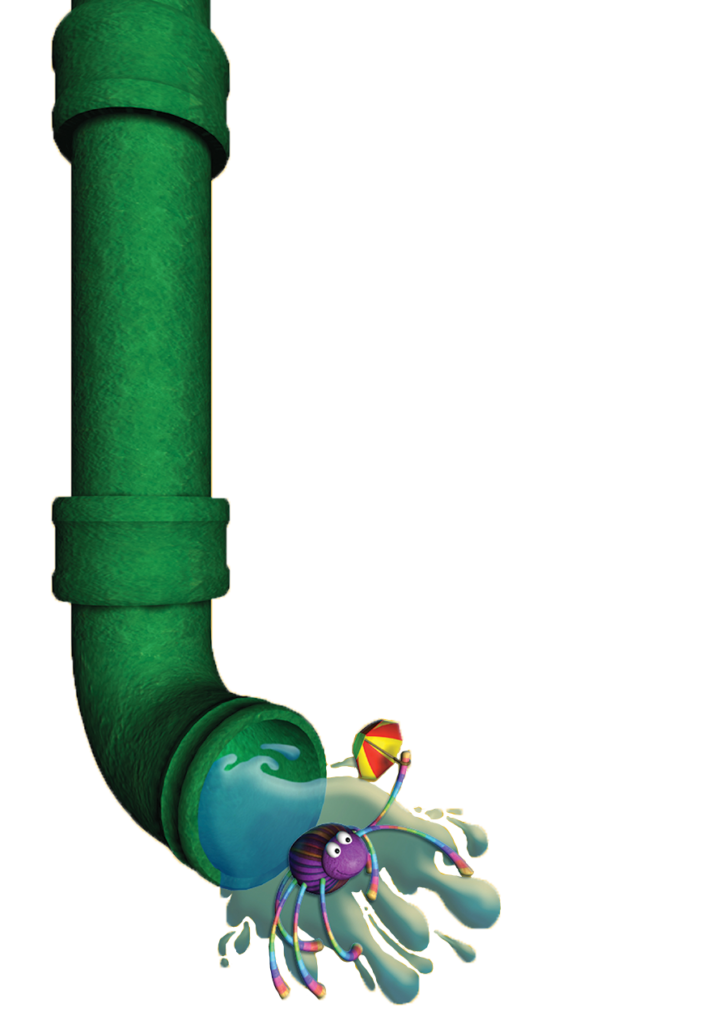
Washed Out!
Listen to the song “Itsy Bitsy Spider.” Explain that you will do an experiment to show how the spider washed down and out of the waterspout. Fill a plastic tub or sink half full with water. Tilt a cookie sheet into the tub. Have your child put a milk bottle cap or small plastic lid (the spider) near the top of the cookie sheet. Then, have your child pour a cup of water onto the cookie sheet above the bottle cap. The water will wash the cap down and into the water. Try washing down several other small objects. Ask: Why do some objects move faster than others?
Bend and Stretch
Stretching increases flexibility and reduces stress. Join your child in stretching.
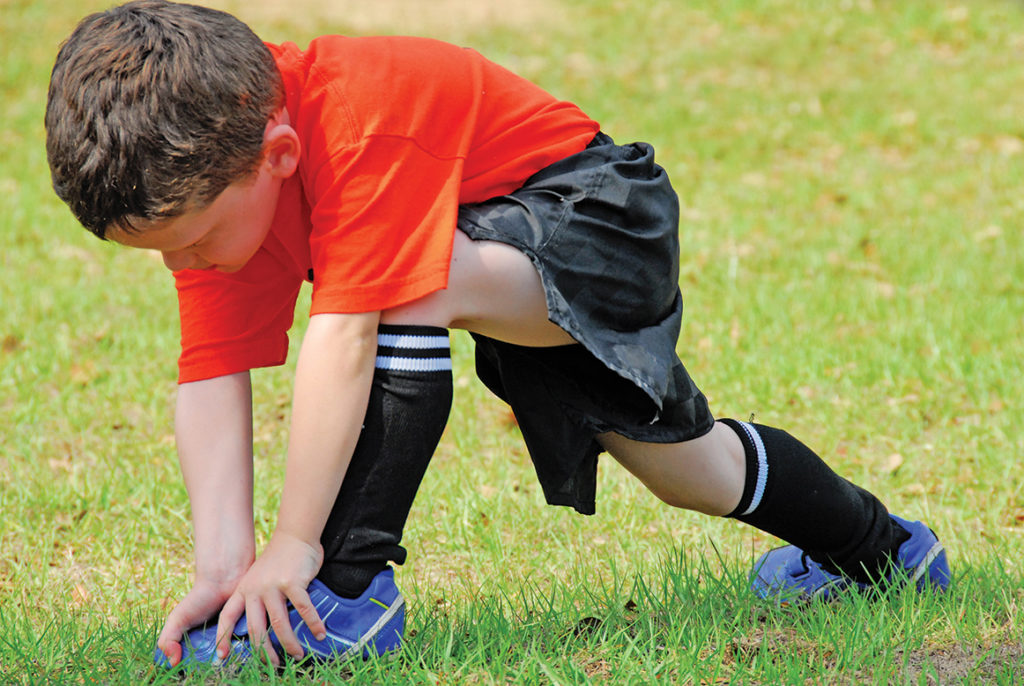
- Start on your hands and knees. Your hands should be directly under your shoulders.
- Move your left foot up to the outside of your left hand.
- Extend your right leg in the lunge position.
- Hold for five seconds and return to original position.
- Repeat with right foot forward and left leg back.
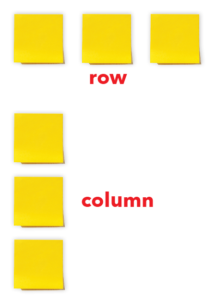
Rows and Columns
Say: Today we will learn more about grids. The groups of squares going across a grid (horizontally) are called rows. Think of some familiar things that are organized in rows (chairs in a theater, cans on a shelf). Have your child arrange three square stick-on notes in a row. Point to and name the left, middle, and right square. Then, have your child rearrange the stick-on notes vertically. Say: In a grid, the squares going up and down (vertically) are called columns. Identify the top, middle, and bottom square. Look around your home for samples of grids.
Pack a Suitcase
Show your child a small suitcase. Ask: If you were going to Grandpa’s house, what would you pack for the trip? Invite your child to show how to pack the suitcase with essentials for an overnight stay.
Reading with your child
Gram Is Coming to My House
Take a picture walk through the book. Stop on pages 6-7. Talk with your child about Gram’s car and the shuttle bus. Ask: How are they different? Where would you store suitcases in these vehicles? On page 9, there are suitcases in a luggage cart. Where will they go on the airplane? Talk with your child about suitcases. Connect your child’s experience with suitcases with the suitcases in the book.
Listen and Write
- Have your child blend the onset and rime to guess the mystery words. Say the onset, pause, say the rime. /p/-ack (pack)
- Say: We can pack a suitcase.
- Draw a horizontal line on paper for each word as you repeat the sentence.
- Write each word of the sentence on a line. Have your child repeat the words with you.
- Ask your child to circle and name letters in the sentence.
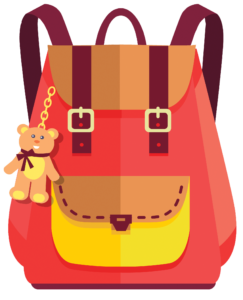
Entertaining Yourself
When you travel, it is important that your child be able to entertain herself. Place a few small toys, snacks, simple games, tablet, and books in a basket. Ask your child to choose items that would be good to use while traveling and explain her choices. Have your child pack the travel entertainment items into a child-size backpack. Then, have your child pretend to be in her car seat and entertain herself with the games.
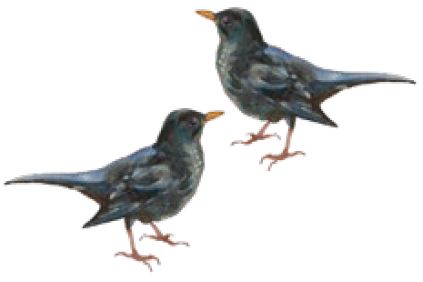
“Two Little Blackbirds”
Listen to the song. Talk about where the blackbirds are and how they move. Sing along as the two of you act out the movements using fists as the blackbirds. Vary the lyrics with the two variations below. Change your fist movements and pitch of your voice to match the new lyrics.
Two little blackbirds watching a show,
One named Fast and the other named S-L-O-W.
Two little blackbirds looking at the sky,
One named Low and the other named High.
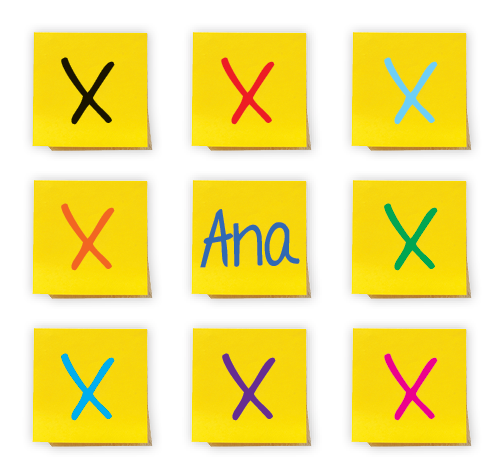
3-by-3 Grid
Have your child put three stick-on notes in a straight row. Help your child build two more rows (one above and one below) to form a 3-by-3 grid. Say: Write your name on the center stick-on note. Ask your child to demonstrate positions by making these marks: red X in top middle, blue X in bottom left, green X in middle right, black X in top left, purple X in bottom middle, orange X in middle left, yellow X in top right, and brown X in bottom right.
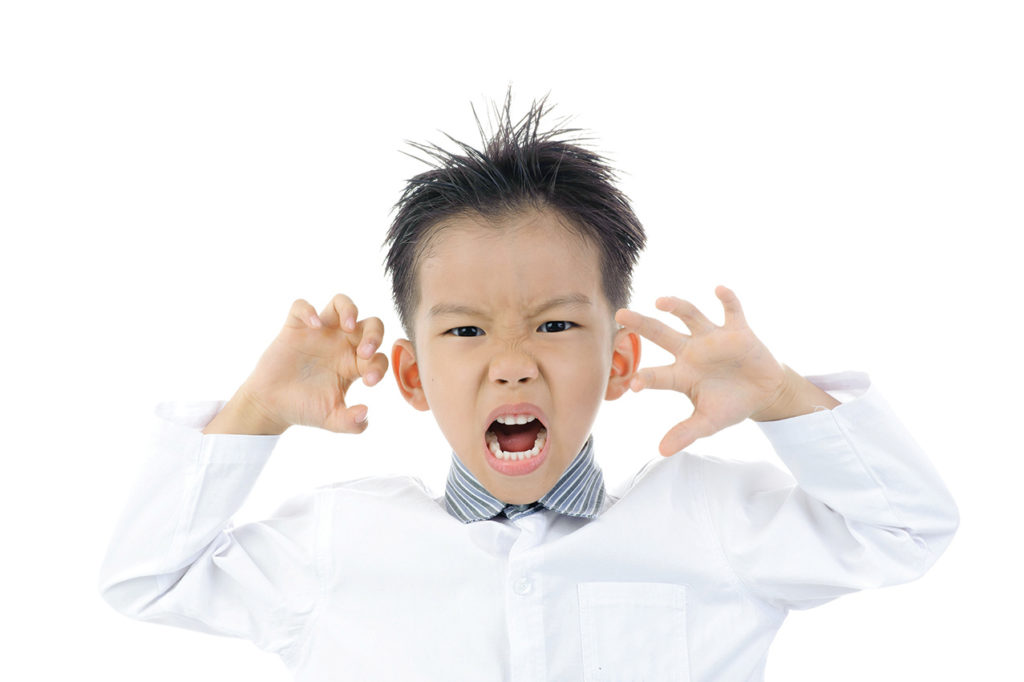
How Do Animals Move?
Have your child show the movements of familiar animals, such as cats, dogs, and rabbits. Suggest a few more unusual animals like crocodiles, eagles, tigers. Point out that animals, as well as people, travel. They change locations.
Reading with your child
Can You Move with Me?
Read the book. Ask: Do you think animals think about moving from one place to another as an adventure?
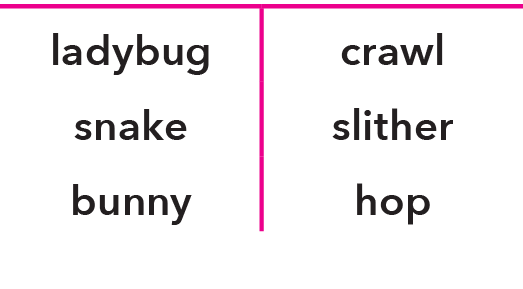
Create a T-chart by drawing a large T on a piece of paper. Print the names of the animals in the story on the left side. Have your child demonstrate each animal’s movement. Write an action word for each movement on the right side.
Listen and Write
- Have your child blend the onset and rime to guess the mystery words. Say the onset, pause, say the rime. /k/-inds (kinds), /w/-ays (ways)
- Say: Animals travel in all kinds of ways.
- Draw a horizontal line on paper for each word as you repeat the sentence.
- Write each word of the sentence on a line. Have your child repeat the words with you.
- Ask your child to circle and name some letters in the sentence.
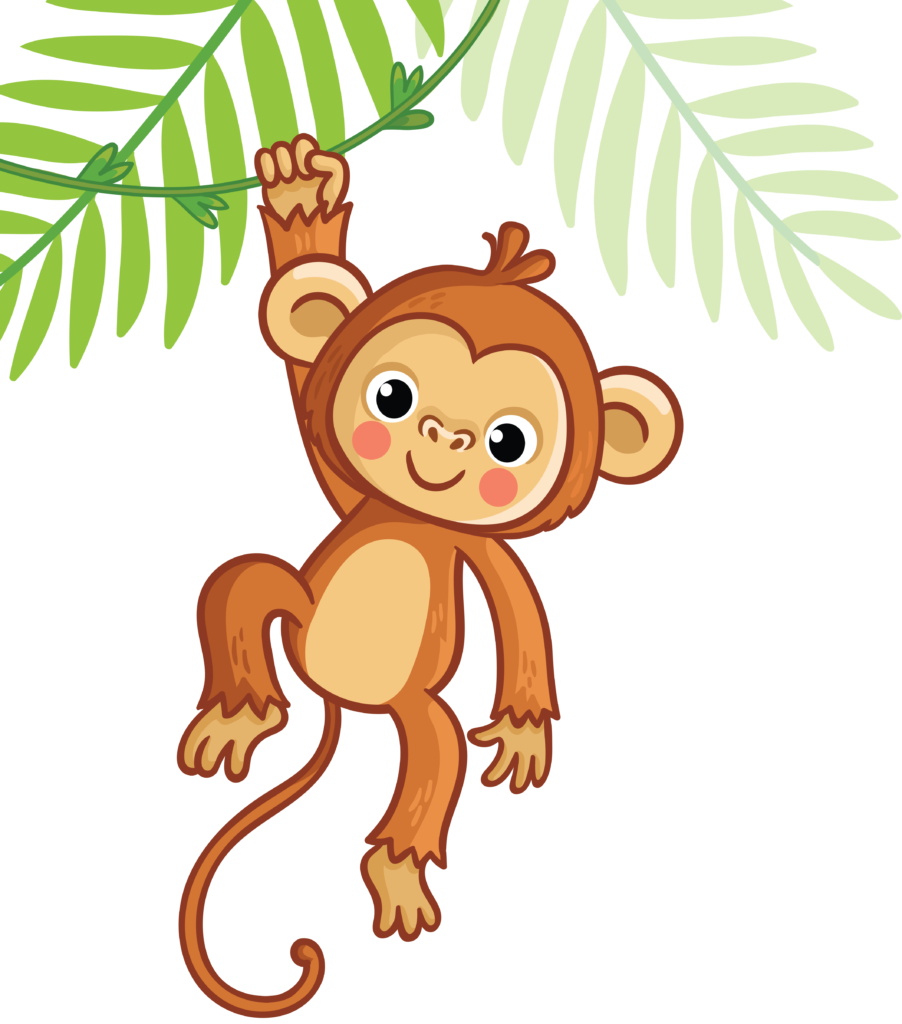
“Ten Little Monkeys”
Listen to the song. Encourage your child to dance about with the upbeat rhythm. Pay particular attention to the verse (one monkey doing tricks, two monkeys picking up sticks, three monkeys standing in lines, four monkeys swinging on vines). Help your child use fingers to keep track of the monkeys. Ask: How many monkeys are there altogether?
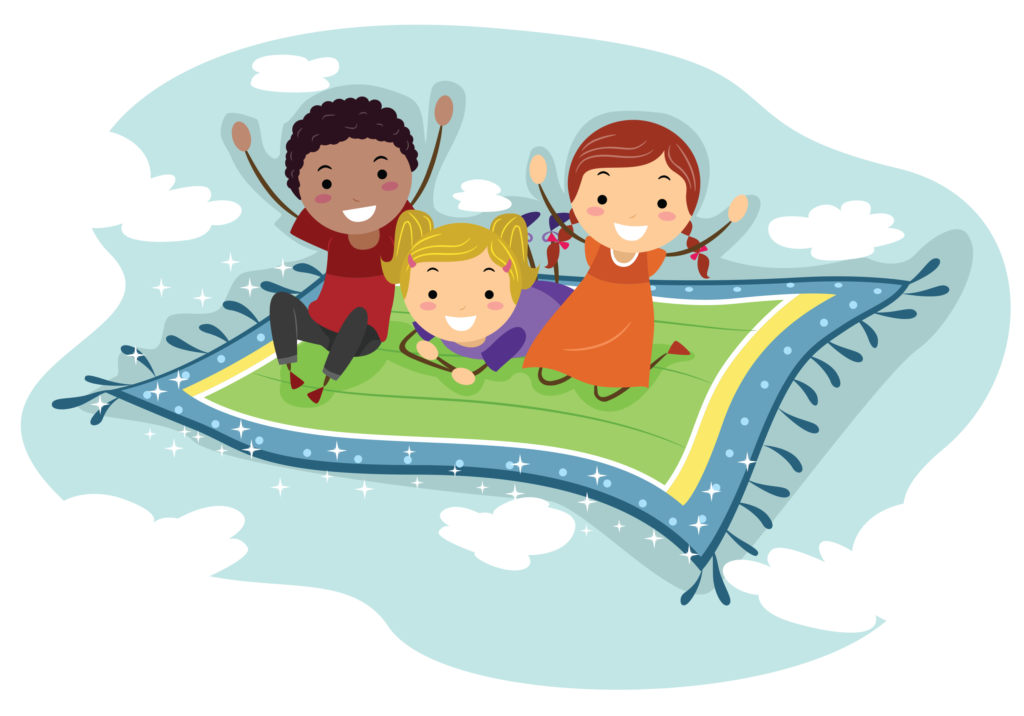
Visualization
Take your child on an imaginary trip:
- Close your eyes and slowly inhale and exhale several times.
- Focus on relaxing your body beginning with feet and moving up to head.
- Picture yourself sitting on a magic carpet.
- Ride your carpet over mountains, oceans, flower gardens, and forests.
- Return safely back to your room.
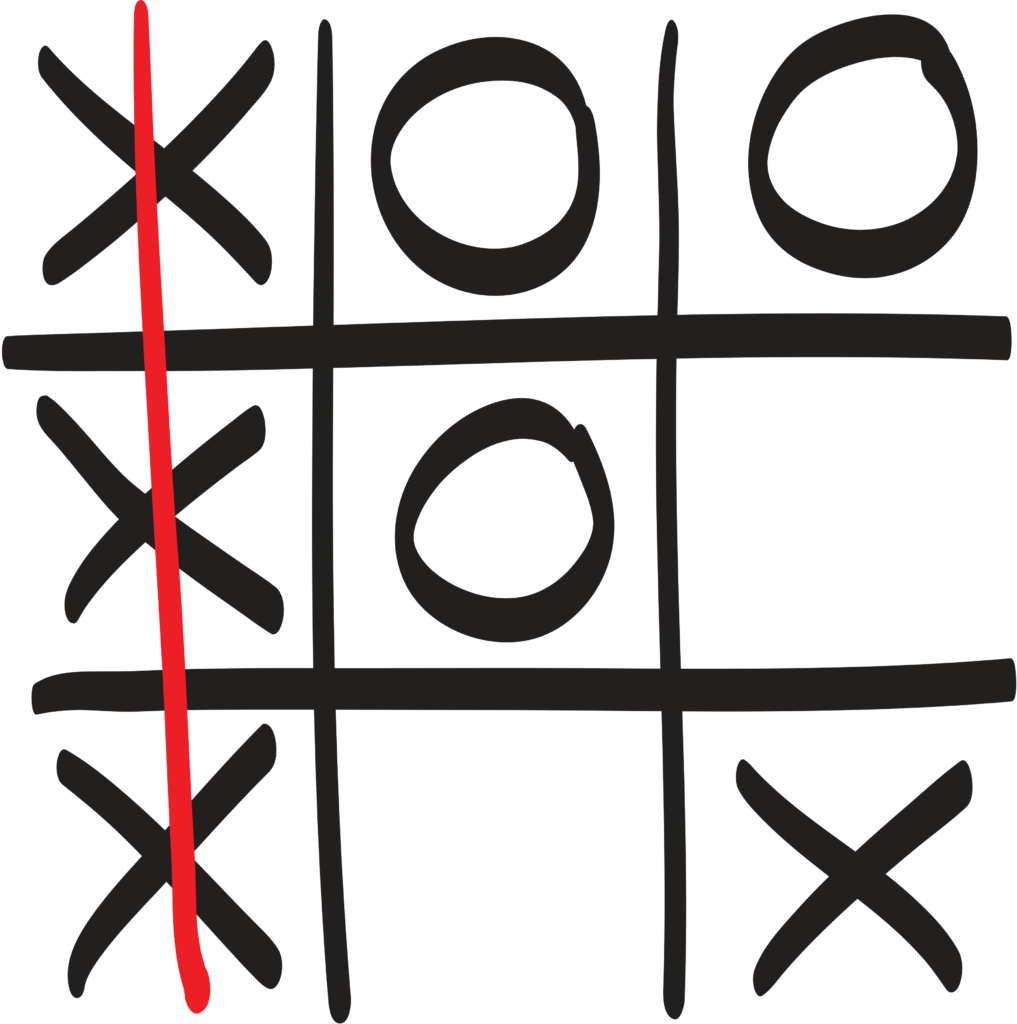
Tic-Tac-Toe
Make a 3-by-3 grid on a sheet of paper. Have your child place a straw in different positions inside the grid: going horizontally across the top three squares; diagonally from the left to the bottom right; vertically across the center three squares. Ask: What other ways can you place the straw across three squares? Review the rules for the game Tic-Tac-Toe and play. When one player gets three markers next to each other (in a row, column, or diagonally) place the straw on top of the three markers to confirm.
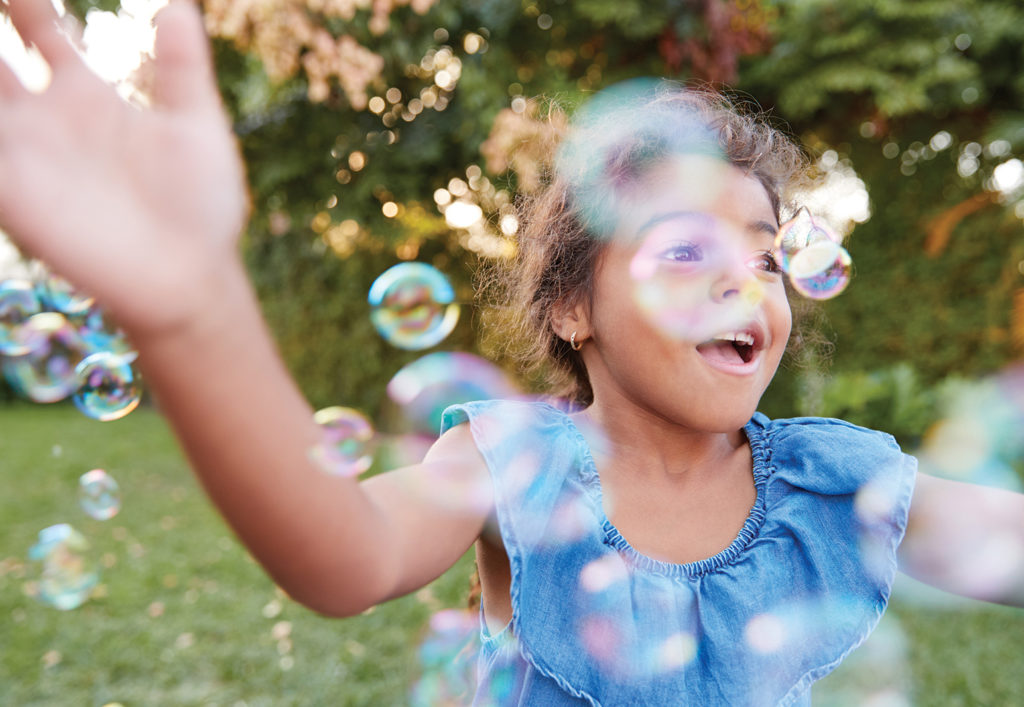
Floating Bubbles
Have your child think about bubbles floating through the air. If you have some bubble solution, blow a few bubbles and watch them float. Play instrumental music and have your child pretend to be a bubble floating on the wind.
Reading with your child
The Three Little Pigs
Have your child briefly retell the story. Point out that the pigs were traveling from their family home to make new homes where they would live on their own. Ask: What do you think the pigs packed in their backpacks for their adventure? Think about how what the pigs packed was different than what Gram packed when she visited her grandson.
Listen and Write
- Have your child blend the onset and rime to guess the mystery words. Say the onset, pause, say the rime. /t/-akes (takes)
- Say: My imagination takes me to many places.
- Draw a horizontal line on a paper for each word as you repeat the sentence.
- Write each word of the sentence on a line. Have your child repeat the words with you.
- Ask your child to circle and name some letters in the sentence.
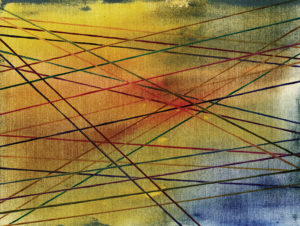
Colored Lines
Place a plastic tablecloth or newspaper on the surface you are using for this project. Pour a small puddle of glue into a shallow container. Have your child dip a piece of colored string or yarn into the glue, carefully lift the string, and lay it on a sheet of heavy paper. Have your child repeat the dip and lay technique with different colored yarn pieces to create a design. Ask: Which lines are horizontal? vertical? Where do the lines cross (intersect)?
This week you and your child will explore vehicles (trains, airplanes, carts, boats, helicopters, buses) used to transport people and materials from one place to another.
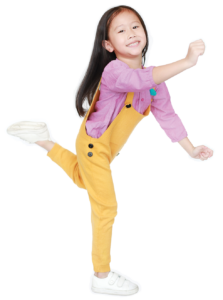
Taking a Trip
Talk with your child about places that you could travel to by car, taxi, tram, or bus. Have your child choose a place. Create a story about visiting the place. Act out the trip together emphasizing actions that require stretching, moving and breathing. Ask: What might we see on our trip?
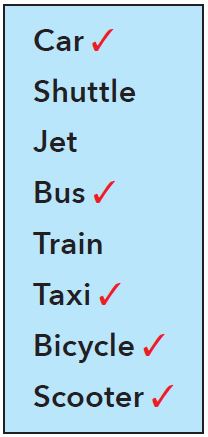
I’ve Traveled in That
Picture walk through Gram is Coming to My House. Make a list of all the vehicles that your child sees. Look at the list again. Read the names of the vehicles one at a time. Have your child put a check mark next to each vehicle he has used to travel. Ask: How many check marks did you make? Count and compare the number of vehicles that your child has not used for travel. Which is more? Note: Keep the list for Day 2.
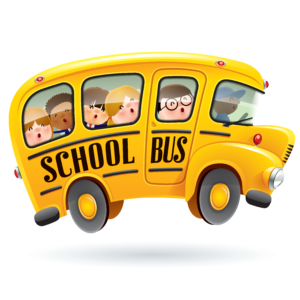
“The Wheels on the Bus”
Sing along with the verses in the song. Encourage your child to think of a movement for each verse. For example, put both hands in front and roll them round and round in a tight circle for the wheels turning.
Reading with your child
Gram Is Coming to My House
Look through the pages of the book to find transportation that has wheels and moves on roads and highways. When your child spots a vehicle that meets the two criteria, name it. Encourage your child to describe experiences riding in any of these vehicles.
Listen and Write
- Have your child blend the onset and rime to guess the mystery words. Say the onset, pause, say the rime. /k/-ars (cars) /r/-oads (roads)
- Say: Cars and buses transport us on roads.
- Draw a horizontal line on paper for each word as you repeat the sentence.
- Write each word of the sentence on a line. Have your child repeat the words with you.
- Ask your child to circle and name some letters in the sentence.
Make a Stop Sign
Give your child six same-size squares of red paper. Give directions for forming an octagon from the squares:
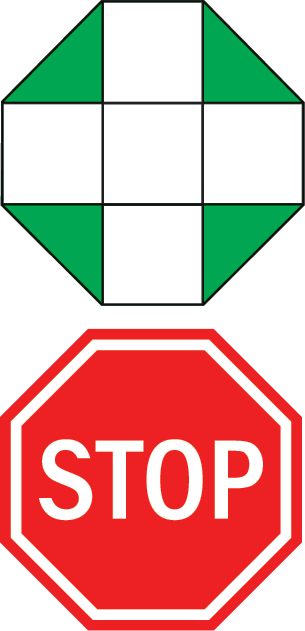
- Make a row of three squares.
- Put another square above the middle square in the row and one below the middle square.
- Cut the remaining two squares in half diagonally.
- Fit one triangle in each space between the top and sides and bottom and sides.
- Count the sides of your shape. (It has eight sides so it is an octagon!)
- Tape or glue the pieces in place.
Help your child use a white crayon or chalk to print the word STOP on the octagon.
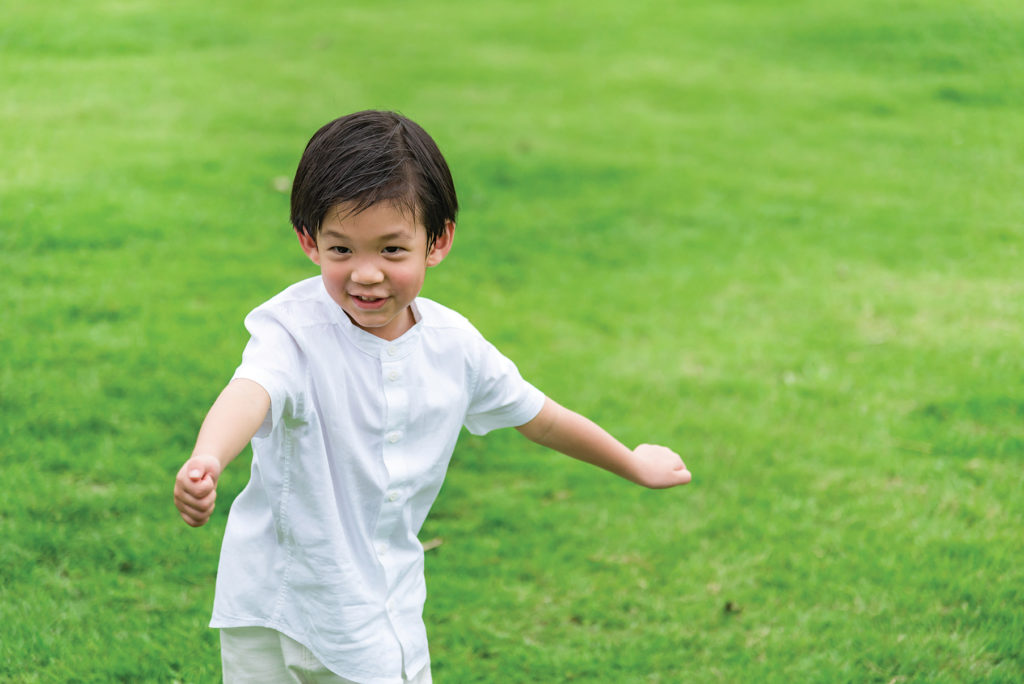
Helicopter
Teach your child the Helicopter. Check to be sure that your child is really stretching to create the blades of the helicopter.
- Stretch your arms to each side to make helicopter blades.
- Gently twist side to side as far as you can.
- Slowly inhale and exhale with each twist.
- Start up slowly, pick up speed, and slow down for the landing.
Make a Graph
Look at the checklist you and your child created on Day 1. Say: Today we will make a graph. It is a picture of the information on the list. On a sheet of paper, make two columns. Label one column Yes (I have traveled in it) and one column No (I have not traveled in it). Prepare a small stick-on note or square paper for each vehicle. Write the name of a vehicle on each note. Starting from the bottom, place the squares representing the vehicles in the correct column. Count the squares in each column. Ask: Which column has more?
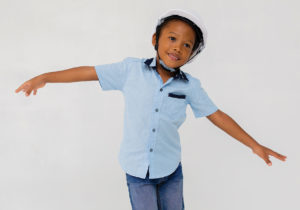
“Airplane Flyers”
Listen to the song. Then have your child hold the lids of two shoeboxes or two plastic plates and fly through the air as you listen again. Ask: What tricks would you like to do in the sky? Where would you fly?
Reading with your child
Once Upon a Time in Dragon Land
Show page 17 of the book. Explain that airplanes are powered by fuel. The ground crew at the airport pumps the fuel into the airplane’s gas tank. When the fuel is in the tank and the passengers are on board, the airplane taxis down the runway and gets into takeoff position. Then it soars into the sky. Read the story. Ask: What kind of a flying game would you like to play if you could fly?
Listen and Write
- Have your child blend the onset and rime to guess the mystery words. Say the onset, pause, say the rime. /m/-ove (move) /p/-eople (people)
- Say: Airplanes and helicopters move people through the air.
- Draw a horizontal line on a paper for each word as you repeat the sentence.
- Write each word of the sentence on a line. Have your child repeat the words with you.
- Ask your child to circle and name some letters in the sentence.
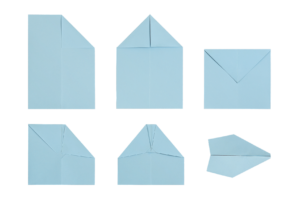
Paper Airplanes
Help your child fold and fly paper airplanes. Set up a starting line and launch several planes to see which flies the longest distance.
Twinkle, Twinkle Little Star
Repeat this rhyme to your child. Ask: Who is being compared to a star?
Twinkle, twinkle, little star
What a wonderful child you are.
With bright eyes and nice round cheeks,
Talented person from head to feet
Twinkle, twinkle, little star,
What a wonderful child you are!
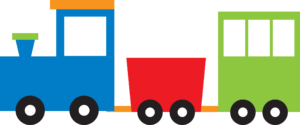
Geometric Shape Train
Cut some geometric shapes (circles, rectangles, squares, and triangles) out of colored construction paper. Have your child arrange the shapes to create a train. Have your child name the shapes and use spatial vocabulary to tell where the shapes are in the creation. For example, your child might say: I made the engine out of a rectangle with a square on top and some circles on the bottom. Count how many of each shape your child used and show the numbers on a chart.
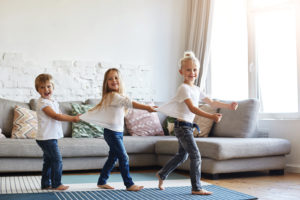
I’m a Choo-Choo Train
Teach your child the words to this rhyme. Gather siblings and have them form a train and move as directed by the rhyme.
I’m a choo-choo train,
Chugging down the track.
First, I go forward,
Then I go back.
Now my bell is ringing.
Hear my whistle blow.
What a lot of noise I make
Everywhere I go!
Reading with your child
Gram Is Coming to My House
Remind your child that Gram used many different forms of transportation when she traveled to her grandson’s house. She rode on two different trains. Read the book to find the two trains (page 15 passenger train, pages 16-19 metro train). The passenger train runs on two long metal rails (bars) on the ground. The metro train is also called a subway train. It goes above the ground like the passenger train and through tunnels below the ground. Ask: How are the seats on the two trains different than seats in a car? Why is the man holding onto a pole on page 18-19? Would you like to ride on a train?
Listen and Write
- Have your child blend the onset and rime to guess the mystery word. Say the onset, pause, say the rime. /m/-ove (move)
- Say: Trains move cargo quickly along the track.
- Draw a horizontal line on a paper for each word as you repeat the sentence.
- Write each word of the sentence on a line. Have your child repeat the words with you.
- Ask your child to circle and name some letters in the sentence.
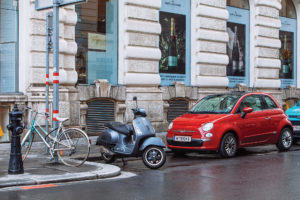
Vehicles I See
Take a walk through your neighborhood with your child. Record all of the vehicles you see on a list or with digital photos. When you return home, review the list. Ask: How many vehicles did we see? Compare your list with the vehicles in the book about Gram. Which vehicles in the book are missing from your neighborhood? Which vehicles in your neighborhood are missing from the book?
Tummy Waves
Teach your child how to make tummy waves:
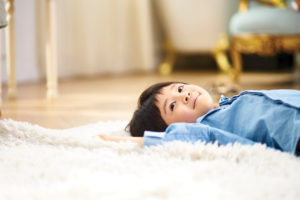
- Lie on your back on the floor.
- Slowly inhale to a slow count of three.
- Exhale to a slow count of five.
- Feel your tummy rise and fall like ocean waves.
Which Vehicle Do I See Most Often?
Review the list of vehicles you saw during the neighborhood walk yesterday. Create a horizontal graph to show the information. Along the left side of a sheet of paper, write the name of each vehicle and draw a simple illustration so your child can “read” the graph.
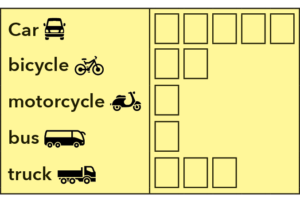
Walk the neighborhood once again carrying the paper. Make a small square for each vehicle you see, next to the vehicle’s name. When you get home, count and compare the number of squares (data) in each category.
A Sailor Went to Sea
Chant the verse and ask: How did the sailor travel to the sea? Point out the two words sea and see. Say: These words sound the same, but they have different meanings. Think of an action to demonstrate each word.
A sailor went to sea, sea, sea,
To see what he could see, see, see.
But all that he could see, see, see
Was the bottom of the deep blue sea, sea, sea.
Reading with your child
Nature’s Giants
Listen to the narrator read the story. Talk about any words in the story that are unfamiliar to your child. Show pages 14-15. Point out the cargo ship. Explain that this ship transports freight across the water, just like big trucks and trains carry freight across the land. Read the information in the Facts box to learn about the Nile River. (4,000 miles is longer than a trip from one side of the United States to the other side.) Ask: What kind of cargo do you think this big ship might carry?
Listen and Write
- Have your child blend the onset and rime to guess the mystery word. Say the onset, pause, say the rime. /b/-oats (boats) /c/-argo (cargo)
- Say: Boats and ships move cargo quickly.
- Draw a horizontal line on a paper for each word as you repeat the sentence.
- Write each word of the sentence on a line. Have your child repeat the words with you.
- Ask your child to circle and name some letters in the sentence.
Build a Boat
Help your child make a sailboat. Use materials you have around your home and your imagination to create a seaworthy craft. These directions are one possibility:
- Cut a construction paper triangle sail.
- Punch three holes along the side of the triangle.
- Weave a straw (mast) through the holes.
- Shape the boat from aluminum foil or plastic lid.
- Anchor the mast in the boat using a ball of clay.
- Try floating the boat in a tub of water.
- If your boat does not float, make adjustments until it is seaworthy.
Roller Coaster Breathing
Teach your child this strategy for breathing. Pretend to go up the hill of a roller coaster as you breathe in and go down the hill as you breathe out. It is a great way to take an active break between lessons.
- Stand with arms at sides.
- Take in a breath as you swing your arms up and rise on your toes.
- Then swoop your arms down as you bend your knees to a squatting position and exhale with a loud swoosh.
- Repeat several times for a great roller coaster ride.
What Does the Data Tell Us?
Review the graph you created yesterday. Explain that graphs help you easily answer questions about how many and make predictions about what might happen.

Ask specific questions about the information (data) on your graph. For example, ask: Which vehicle did we see most often? Why did we see so many ____? Talk about how creating a graph makes the information easier to understand.
The Carousel Ride
Carousel is another name for a merry-go-round. If your child is not familiar with this carnival ride, do a quick search on the internet and show your child a few photos. Explain that children and adults ride models of horses or other animals that are attached to a large circle. The horses go up and down as the circle turns around. Teach your child this verse about a carousel and act it out going up and down as you travel around in a circle.
The horses go up, the horses go down,
As the carousel turns ‘round and ‘round.
The music plays brightly.
The girl (boy) shouts with glee,
“Hey Mom and Dad, just look at me!”
Reading with your child
Giants Made by People
Show pages 8-9. Discuss the carnival rides on these pages. Talk about how these rides could be called transportation. Ask: Do the rides move passengers from one spot to another? Read the book. Pause on each page to have your child name the vehicles that transport people or cargo. Ask: What are some your favorite kinds of transportation?
Listen and Write
- Have your child blend the onset and rime to guess the mystery word. /r/-ide (ride)
- Say: Everyone enjoys a carnival ride.
- Draw a horizontal line on paper for each word as you repeat the sentence.
- Write each word of the sentence on a line. Have your child repeat the words with you.
- Ask your child to circle and name some letters in the sentence.
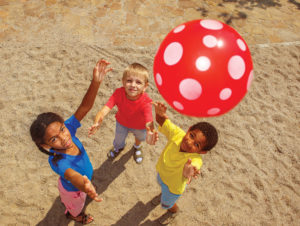
Keep Away
Gather all of your family members and play a game of Keep Away. The object of the game is for teammates to keep a beachball or soft stuffed ball away from the other team. (The game can be played with as few as three players.) Teammates stand opposite each other and throw the ball back and forth. Member(s) of the second team stand between the first team members and try to grab the ball. If the second team gets the ball, then the two teams reverse positions.
You can’t see wind, but wind can move things. This week you and your child will explore “sneaky” movers like wind that transport objects from one place to another.
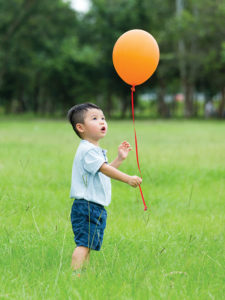
Balloon Calming Strategy
Review the Balloon calming strategy. When the balloon is inflated (arms are extended above head) sway back and forth as if the balloon is being moved by the wind. Make the sound of air escaping as the balloon deflates and your hands rest on top of your head. Say: Think about how a helium balloon floats and moves. Who controls its moves? What happens when you let its string go?
Turning, Sliding and Flipping
Draw a 2-by-2 grid on paper. Place a photo of your child in the top left square. Have your child close his eyes as you move the photo. For example, turn it sideways inside the same square or slide it down to the bottom left square or flip it over so it is face down inside the top right square. After each move (transformation), have your child describe how the photo moved (turn, slide, flip).

Twirl Around
Talk about how leaves on tree branches move in the wind. Read the verse and have your child twirl in the pretend wind and drop to the ground. After a count of three, hop up and begin the verse again. (This pantomime game is similar to Ring Around the Rosie.)
Like a leaf or a feather
In the windy, windy weather,
We will twirl around
And all sink down together.
Reading with your child
Mysterious Movers
Show the cover of the book. Explain that this book is written in haiku, a form of Japanese poetry. Turn to page 7. Ask: What do you think is happening on this page? Read the haiku and confirm that the author is talking about seeds blowing in the wind. Ask: What is the author telling the seeds to do? Do you think that the seeds will land in a good place to grow?
Listen and Write
- Say: Is the wind quiet or busy today?
- Write the question word by word having your child repeat the words with you.
- Point out the question mark at the end and explain that this is an asking sentence.
- Have your child look out of the window, check the wind, and answer the question.
- Help to frame your child’s answer as a complete sentence. (The wind is ____ today.) Write your child’s answer below the sentence.
Wind Chimes
If you have a wind chime, show it to your child. If not, describe one: A wind chime is often hung in a tree. Its hanging parts move when the wind blows. When the parts hit each other, they make a pleasant noise or chime. Work together to make a wind chime. Attach “noisemakers” (bells, pieces of wood, washers, shells) with string to a stick. Hang your chime in a tree and wait for a breeze. Point out that even though the wind is invisible, the movements and sounds of the chime show that the wind is blowing.
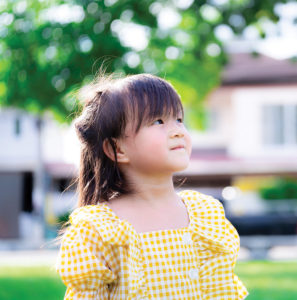
“Caring Friends”
Listen to the song. Explain that the phrase “shine your light near and far” means to do thoughtful things for other people. Ask: How do you shine your light near and far? Listen to the song again and sing along, shaking and holding hands as directed.
Moving Left or Right
Create a horizontal number line (1-10) on a strip of paper. Have your child place a clothespin on the numeral on the line that tells her age. Ask your child to name (or point to) the numeral that comes before and after that numeral. Then have your child move to other numerals on the number line. For example, say: Move to 8. Ask: Will you go left or right? How many numerals will you cross?

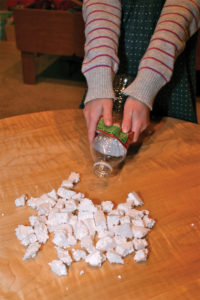
Air Movers
Talk with your child about tools you can use to move air (paper fans, straws, cardboard tubes, plastic squirt bottles). Collect some movers you have around your house. Have your child explore moving Styrofoam pieces or a Ping-Pong ball with the movers. Ask: Which mover do you think is best? Why?
Reading with your child
Mysterious Movers
Show the cover of the book. Tell your child that this book reflects both the art and writing of the Asian culture. Ask: What does mysterious mean? (unexplained or puzzling) Picture walk through the book. Stop on pages 10-11 and read the two haikus on these pages. Ask: Who is the mysterious mover on these pages? What water besides the ocean is a mover?
Listen and Write
- Say: What treasures could the waves bring to shore?
- Write the first word explaining that it begins with an uppercase letter. Write the rest of the question word by word having your child repeat the words with you.
- Point out the question mark at the end and explain that this is an asking sentence.
- Have your child answer the question.
- Help to frame your child’s answer as a complete sentence. (The waves could bring ____.) Write the answer below the sentence.
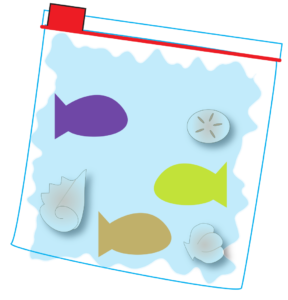
Ocean in a Bag
Cut out a few fish shapes from Styrofoam trays or milk cartons. Help your child put about one-fourth cup of hair gel into a resealable plastic bag. Add the fish shapes and a few small shells or beads. Close the bag and seal it with a strip of duct tape or a line of white glue. (If you use glue, wait to use the bag until the glue is dry.) Have your child move fingers gently over the bag to move the shells and fish.
Stretching Exercises
Invite your child to join you in some stretching exercises. Jump forward, backward, and side to side. Do five jumping jacks. Leap over a pretend stream. Try to reach the sky. These stretches and exercises are an effective way to release stress.

A Vertical Number Line
Create a vertical number line (1-10) on a strip of paper. Challenge your child to name the numeral that is above 4, but below 6. Mark the numeral with a clothespin. Tell your child to pretend that the number line is a tower and that there is an elevator that goes up and down to reach each floor. Give directions, telling your child to move to different floors. For example, say: Move to 3. Ask: Will you need to press the up bottom or the down button for the elevator? How many floors will you go?
Make a Marble Run
Create a marble run (racetrack) with your child. You will need several empty paper-towel or gift-wrap tubes. If you cut the tubes in half, you double the number you have to work with and they form nice “half-pipe” runs. Make your run as simple or as complicated as you like.
- Tape an empty paper-towel tube to the edge of a table or chair.
- Then tape another tube to the bottom of the first tube.
- Continue taping tubes together until you reach the floor.
- Tip the last tube so that it points to the side.
Drop a marble into the top of the first tube. Ask: What happens? How can we add tubes to change the run? What would happen if we build our run on top of a table in a straight line?
Reading with your child
Mysterious Movers
Tell your child that today you will read a haiku about a brook. Confirm that a brook is like a river, but smaller. Turn to pages 16-17. Have your child describe the illustration. Read the haiku. Ask: How does the author say that the water moves? (ripple, dance) What else does the brook do? (sing a splashing song) Challenge your child to tell which direction the water is moving. Ask: What clues helped you answer?
Listen and Write
- Say: Does the marble roll up or down?
- Write the first word explaining that it begins with an uppercase letter. Write the rest of the question word by word having your child repeat the words with you.
- Point out the question mark at the end and explain that this is an asking sentence.
- Have your child answer the question.
- Help to frame your child’s answer as a complete sentence. (The marble rolls _____.) Write the answer below the sentence.
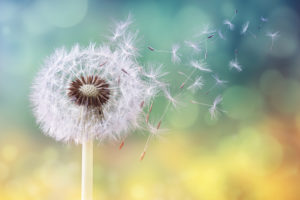
Seeds Travel Too
Have your child put a pair of old white socks over his shoes. Take a walk outside or play in the yard. When you are back in the house, check the socks for traveling seeds (seeds that are stuck on the socks). Talk briefly about how seeds sometimes travel on clothing, shoes, and pets. Visit a vacant lot where weeds are growing. Keep your eyes out for seeds that travel in the wind or by attaching themselves to moving objects. Ask: Do seeds attach themselves to your pant legs? Are there dandelion seedpods growing there? How do dandelion seeds travel?
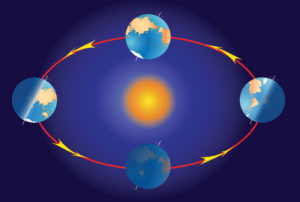
Mr. Sun
Explain to your child that the sun does not move away at the end of a day. It stays in place. It is the earth that is moving. Draw the sun on your child’s hand. Then have your child extend the hand, standing in place, as you revolve around the sun as the earth would.
Oh, Mr. Sun, Sun
Mr. Golden Sun,
Won’t you smile down on my
(son, daughter, dad, mom)?
(repeat)
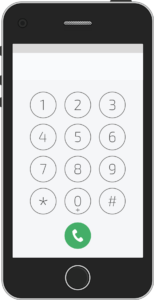
Cell Phone Design
Show your child the display of numerals on a cell phone. Discuss how the numerals are arranged in rows and columns. Point out how the sequence of numerals moves from left to right and top to bottom (1-3 in the first row, 4-6 in the second row, 7-9 in the third row). Point out the * sign, 0, # sign in the bottom row. Have your child press numerals as you name them. Your child might practice entering your phone number.
Slow Motion Moon Dance
Explain that gravity is a force that attracts objects to each other. Because the pull of gravity is stronger on Earth than it is on the moon, you would weigh less on the moon. If you were to jump while on the moon, you would be able to jump higher (floating up easily) and land back on the moon’s surface gently. Demonstrate how it might look to walk, hop, and dance on the moon (basically moving in slow motion). Invite your child to imitate your movements and do a moon dance.
Reading with your child
Twinkle, the Little Star
Remind your child that this book is about a star named Twinkle. Turn to page 5 and point to Twinkle in the illustration. Gerry West, the author, describes Twinkle as “a tiny, shimmering, shining speck.” Talk about the words pointing out that tiny and speck describe Twinkle’s size, while shimmering and shining tell about how she looks. Have your child pretend to shimmer and shine. Read the story. Ask: Why do you think Twinkle and her sisters bowed when the sun began to rise? When do performers in a play bow?
Listen and Write
- Say: What do you see that twinkles?
- Write the first word explaining that it begins with an uppercase letter. Write the rest of the question word by word having your child repeat the words with you.
- Point out the question mark at the end and explain that this is an asking sentence.
- Have your child answer the question.
- Help to frame your child’s answer as a complete sentence. (The _____ twinkle(s).) Write the answer below the sentence.
Watch It Flow
Explain that flow is a word we use to describe the way liquids move. Ask: Do you think that all liquids flow at the same speed? Give your child a paper plate. Place a small amount of hand lotion, glue, liquid soap, and paint along one edge of the plate. This edge is the top. Have your child tilt the plate gently and watch the liquids flow. Encourage your child to notice the differences in flow by asking questions: Which one moves the fastest? Slowest? Why? Explain that all liquids flow, but the thickness of the liquid determines how fast it moves.

Arm Breathing
Review this breathing exercise:
- Lift both arms over your head as you slowly inhale to a count of five.
- Drop your arms slowly as you exhale to a count of three.
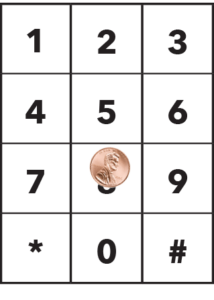
Moving on a Grid
On a sheet of paper, draw a 3-by-4 grid. Add numerals so that it looks like the face of a cell phone. (Note: It should be larger than a cell phone face.) Place a penny on the * sign in the grid. Direct your child to move a penny or bottlecap in different directions (up, down, left, and right) on the grid. For example:
- Move up one square and move right one square.
- Move two squares to the left and move one square up.
- Move right two squares and down one square.
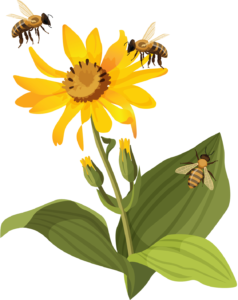
Waggle Dance
This dance copies the movement of bees as they gather nectar from flowers. Bees communicate with other bees by moving their bodies. When they find a good source of nectar, they wiggle their bodies and circle around the flowers. Place a paper or plastic flower in the center of an open area and have your child pretend to be a bee gathering nectar. The “bee” should circle around the flower and wiggle its body before flying off with its nectar.
Reading with your child
Animal Movers
Copy the poem below onto a big piece of paper before the lesson. Draw small pictures of the animals by each line. Have your child act out each line as you read it. After reading, talk about how the animals moved things. Explain that incredible means astonishing or remarkable. Ask: Do you think that the things these animals do are incredible? Are these animals mysterious movers?
Bees pick up pollen on their legs and carry it to another flower. Ants pick up crumbs and carry them with superpower. Birds gather twigs to build their nest. They eat berries and digest the seeds. All of these things are incredible good deeds.
Listen and Write
- Say: What did the animal move?
- Write the first word explaining that it begins with an uppercase letter. Write the rest of the question word by word having your child repeat the words with you.
- Point out the question mark at the end and explain that this is an asking sentence.
- Have your child answer the question.
- Help to frame your child’s answer as a complete sentence. (The animal moved the _____.) Write the answer below the sentence.
Paint with a Magnet
Place a few drops of paint on a piece of paper that is on top of a cookie sheet. Place a metal washer in the paint. Hold the cookie sheet so that your child can reach under it. Have your child use a magnet under the cookie sheet to move the washer through the paint to create a picture. Ask: How does moving a washer with a magnet seem mysterious?


